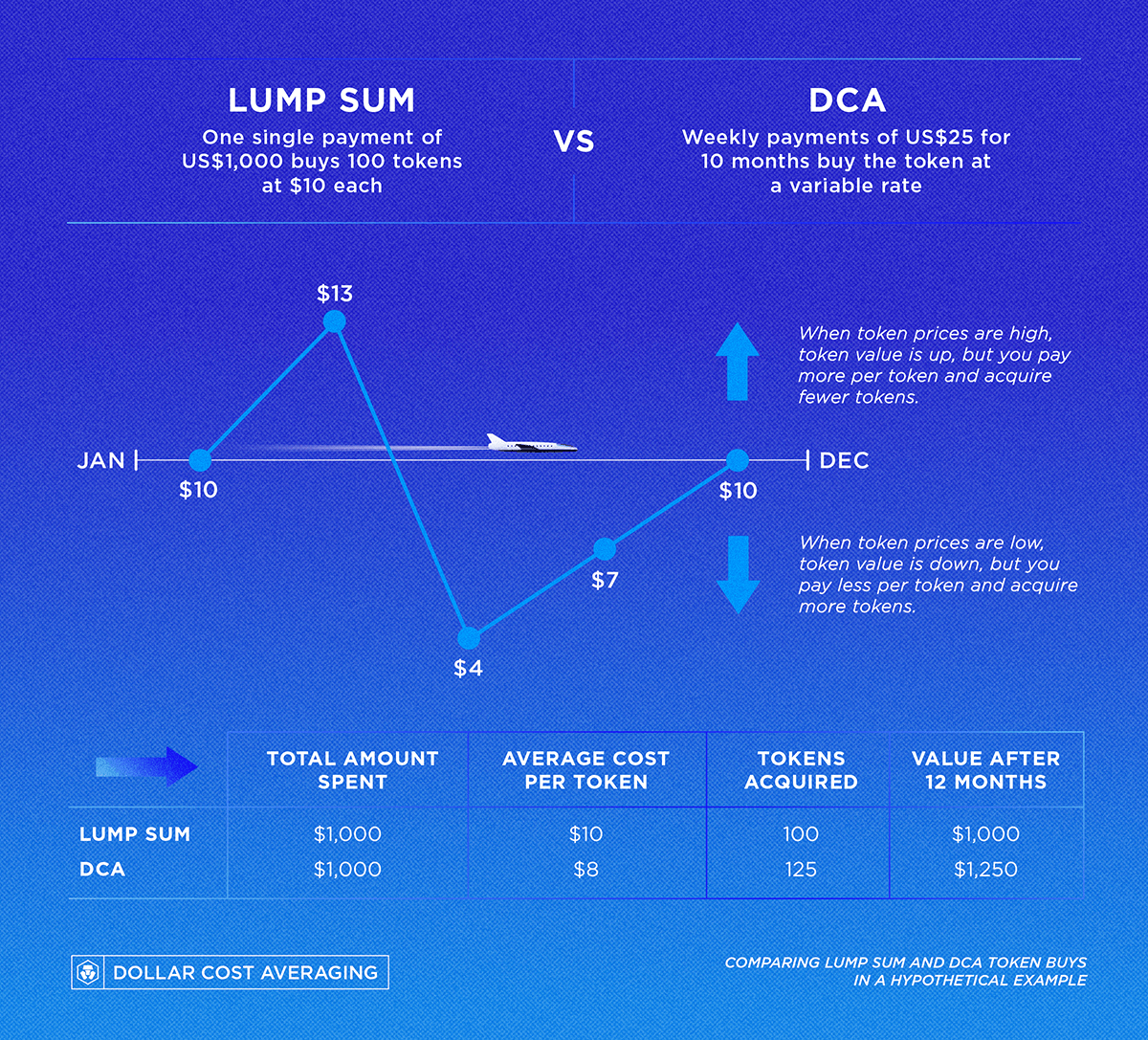How Does Dollar Cost Averaging Work?


Since the conception of cryptocurrencies, people have tried to ‘time the market’ (i.e., pinpoint the ideal time to buy or sell crypto). In absence of a crystal ball, this has proven difficult — even for professional investors who spend all their time studying the market. In other words, few succeed with this strategy.
What is the alternative?
Enter Dollar Cost Averaging, known as DCA in both the crypto space and stock market realm. It refers to consistently investing a small, fixed amount of money, which over time may yield better results, while saving you time and your nerves. Here is how to do it.
DCA is defined as the process of allocating a fixed amount of money at a regular interval to purchase an asset. For example, setting aside US$100 every Monday to buy Bitcoin.
Spreading out purchases evenly instead of making a lump-sum buy can reduce the chance of major financial loss, which is good not only for your wallet but also your peace of mind. DCA is an especially popular strategy for crypto users who want to remain engaged with an asset during bear markets.
In this article, find out more on how DCA works, the pros and cons, and how to easily set it up.
Mục lục bài viết
Key Takeaways:
- Dollar Cost Averaging (DCA) is a strategy that allocates a fixed sum of money in regular intervals to buy an asset. This is done in hopes of reducing the impact of asset price volatility and lowering the average cost per share over time
- The DCA method is a proven and popular accumulation strategy in both traditional financial markets and the crypto world
- Users can automate DCA on the Crypto.com Exchange and in the App
What is Dollar Cost Averaging (DCA)?
DCA operates on the principle of allocating a set amount of capital on a regular schedule (e.g., weekly, biweekly, monthly) into a chosen asset. This is done to minimise the impact of price fluctuations by levelling out the average buying cost for the asset. Instead of making a lump-sum purchase, users divide their funds into smaller amounts that are distributed at regular intervals.
But why wouldn’t you rather invest all your capital into an asset with its market price at its lowest? Because it is difficult to know when that will happen.
This is also known as ‘timing the market’, and data shows that even financial professionals struggle to time the market well. If those whose career is focused on understanding and predicting the market have a hard time doing so, the odds for everyday crypto users are likely even less in their favour.
By automating purchases and removing emotions from the equation, DCA is often shown to outperform other strategies like lump-sum investments, given that the average cost per share at the end of an allocation period is less than the current market price per share.
Why DCA?
This form of trading is not exclusive to the crypto world and has been utilised for decades in traditional finance (TradFi). Its main purpose is to skip the otherwise necessary step of timing the market in order to turn a profit; or, in other words, to offer an alternative to the lump-sum (LS) strategy.
LS is a method in which all available capital is allocated into an asset at the same time. Those who utilise this strategy wait for assets to drastically decrease in market value so they can buy at the lowest possible price and sell when the prices increase.
Theoretically, ‘buying the dip’ seems simple; yet, deciphering when an asset has actually hit the bottom of its price range is difficult, even for advanced traders.
A possible issue with the ‘buy low, sell high’ approach can be observed in times of a bearish market. If the market is timed incorrectly, you could end up losing a substantial amount of money. However, on the off chance you’ve timed the market correctly, you can turn in significant profits.
DCA is strongly recommended by economists to beginners who lack the time or experience ‘to forecast market returns or who become upset during bear markets, as it might help them buy when the market is down and stocks are cheap — if they stick to the plan.’
Research shows that DCA outperforms other strategies during bear markets by a significant margin if done consistently, mostly due to the lower risk associated with it (Brennan, et. al., 2005).
The best time to buy an asset is when the asset is at its lowest possible price. However, when prices drop and a bear market is ongoing, the opposite tends to happen. Many traders get anxious about their funds and sell whatever assets they hold, in an attempt to limit their losses.
One of the reasons why DCA is so effective is because it eliminates the weight our emotions have on financial decisions.


This hypothetical example illustrates why DCA may be a preferred strategy during bear markets — the lower asset prices result in a higher amount of shares obtained.
Another reason why DCA is seen as a preferred strategy: there is no downtime on available funds — they are actively used instead of held onto in hopes of timing the market or due to FOMO (Fear of Missing Out). This is expressed in the adage, “What beats timing the market is time in the market.”
How to Set Up Automated DCA
Now that we’ve covered how DCA operates and how users can benefit from it, let’s actually begin utilising it.
Crypto.com offers a DCA Trading Bot on the Exchange. Trading Bots allow users to build their positions without having to constantly follow the market, as they automatically place and execute orders if they meet pre-existing conditions and parameters. This feature is available for all users on the Crypto.com Exchange platform. For a step-by-step guide on how to set up your DCA Trading Bot, please refer to our Help Centre article.
Exchange Web now also offers a Pre-Set DCA Bot. The ‘Popular DCA Bots’ section showcases the year-to-date top 8 DCA Bots that users have created and are available for use.
DCA can be employed on the Crypto.com App, as well, known as Recurring Buy.
The Recurring Buy feature gives App users the ability to apply the DCA strategy by scheduling recurring purchases for over 70 cryptocurrencies on a daily, weekly, biweekly, or monthly basis. Users can set up recurring crypto purchases using a credit card, crypto wallet, or fiat wallet in the Crypto.com App.
Conclusion
Dollar Cost Averaging (DCA) is an easy way to build your position in crypto, especially for beginners. If you find yourself holding on to your assets, never knowing when the right time is to re-enter the market, employing DCA can help leave your anxiety at the door.
Now that you’ve got the basics down, you’re ready to start making scheduled purchases with our DCA Trading Bot or by setting up recurring crypto purchases with Recurring Buy on the Crypto.com App.
For those wanting to explore timing the market, our University article How to Read Crypto Charts — A Beginner’s Guide is an intro to technical analysis.
Due Diligence and Do Your Own Research
All examples listed in this article are for informational purposes only. You should not construe any such information or other material as legal, tax, investment, financial, or other advice. Nothing contained herein shall constitute a solicitation, recommendation, endorsement, or offer by Crypto.com to invest, buy, or sell any coins, tokens, or other crypto assets. Returns on the buying and selling of crypto assets may be subject to tax, including capital gains tax, in your jurisdiction.
Past performance is not a guarantee or predictor of future performance. The value of crypto assets can increase or decrease, and you could lose all or a substantial amount of your purchase price. When assessing a crypto asset, it’s essential for you to do your research and due diligence to make the best possible judgement, as any purchases shall be your sole responsibility.











